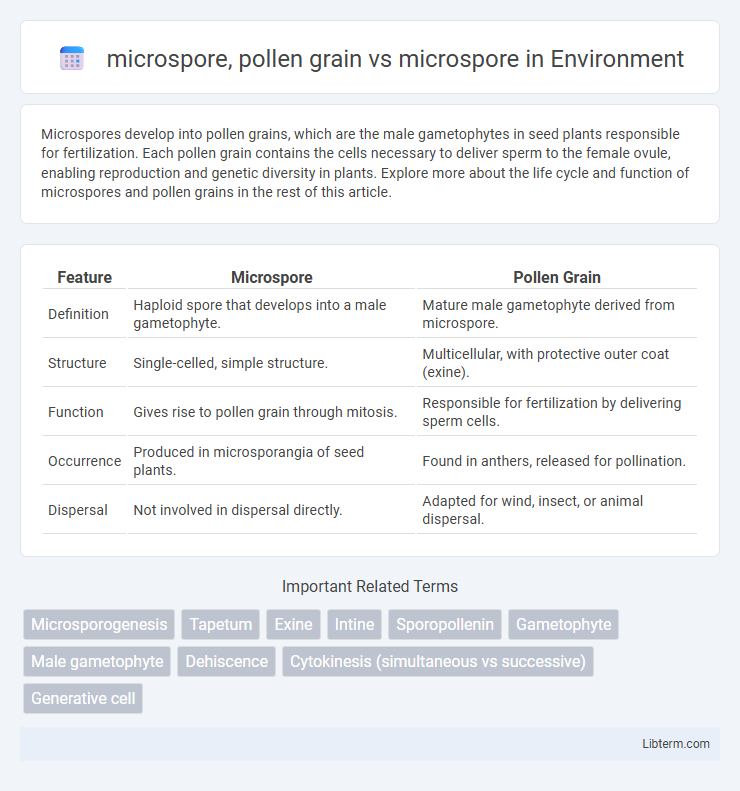Microspores develop into pollen grains, which are the male gametophytes in seed plants responsible for fertilization. Each pollen grain contains the cells necessary to deliver sperm to the female ovule, enabling reproduction and genetic diversity in plants. Explore more about the life cycle and function of microspores and pollen grains in the rest of this article.
Table of Comparison
| Feature | Microspore | Pollen Grain |
|---|---|---|
| Definition | Haploid spore that develops into a male gametophyte. | Mature male gametophyte derived from microspore. |
| Structure | Single-celled, simple structure. | Multicellular, with protective outer coat (exine). |
| Function | Gives rise to pollen grain through mitosis. | Responsible for fertilization by delivering sperm cells. |
| Occurrence | Produced in microsporangia of seed plants. | Found in anthers, released for pollination. |
| Dispersal | Not involved in dispersal directly. | Adapted for wind, insect, or animal dispersal. |
Introduction to Microspores
Microspores are haploid spores produced by the meiosis of diploid microsporocytes within the anthers of seed plants. Pollen grains develop from microspores through a process called microgametogenesis, where each microspore undergoes mitotic division to form the male gametophyte. Understanding microspores is crucial in studying plant reproduction, as they represent the initial stage leading to pollen grain formation and subsequent fertilization.
Microspore Formation in Plants
Microspore formation in plants involves the development of microspores within the anthers through meiosis of microsporocytes, resulting in haploid cells that eventually mature into pollen grains. While microspores are the initial unicellular products of meiosis, pollen grains represent the later multicellular structures containing male gametophytes ready for fertilization. The transition from microspores to pollen grains is critical for plant reproduction, as pollen grains facilitate the transfer of male genetic material to the female ovule.
Structure and Function of Microspores
Microspores are haploid spores that develop into pollen grains, serving as the male gametophytes in seed plants. Structurally, microspores possess a thick exine layer for protection and a thin intine layer that supports cellular growth, essential for fertilization. Functionally, microspores undergo mitotic division to form pollen grains, which facilitate the transfer of male genetic material to the ovule for reproduction.
What Are Pollen Grains?
Pollen grains are the mature, multicellular male gametophytes arising from microspores through mitotic divisions, essential for plant reproduction as they carry sperm cells to ovules. Microspores represent the early haploid stage in the life cycle, produced by meiosis within the anthers, and develop into pollen grains capable of fertilization. Unlike microspores, pollen grains are structurally complex, featuring protective outer walls called exines that facilitate dispersal and protect the genetic material during fertilization.
Formation of Pollen Grains from Microspores
Pollen grains develop from microspores through a process called microsporogenesis, where diploid microspore mother cells undergo meiosis to form haploid microspores. Each microspore then undergoes mitotic division and differentiation to form a mature pollen grain, consisting of a generative cell and a vegetative cell enclosed by a pollen wall. This transformation from microspore to pollen grain is crucial for plant reproduction, enabling the transfer of male genetic material during pollination.
Microspore vs. Pollen Grain: Key Differences
Microspores are haploid spores produced by the microsporangium during the sporophyte generation, serving as the precursor cells that develop into pollen grains through mitotic division. Pollen grains, in contrast, are the mature male gametophytes in seed plants, containing sperm cells necessary for fertilization. The key difference lies in their development stages: microspores are early haploid structures, whereas pollen grains represent the fully developed, multicellular male gametophyte ready for pollination.
Microspore Developmental Stages
Microspore developmental stages include microsporogenesis, where diploid microsporocytes undergo meiosis to form haploid microspores, followed by microgametogenesis during which pollen grains mature. The microspore is a single haploid cell that develops into a multicellular pollen grain composed of a generative cell and a vegetative cell, essential for plant fertilization. Understanding these stages is crucial for studying pollen viability, germination, and successful fertilization in angiosperms.
Biological Significance of Microspores and Pollen Grains
Microspores are haploid cells produced by meiosis in the microsporangia of seed plants, serving as precursors to pollen grains, which are the mature male gametophytes responsible for fertilization. Pollen grains encapsulate the male gametes and facilitate their transfer to the female ovules through pollination, playing a crucial role in sexual reproduction and genetic diversity in angiosperms and gymnosperms. The biological significance lies in the microspore's development into pollen grains, enabling efficient male gamete dispersal and ensuring successful fertilization for seed formation.
Microspores and Pollen Grains in Plant Reproduction
Microspores develop into pollen grains through mitotic divisions, playing a crucial role in plant reproduction by producing male gametophytes that facilitate fertilization. Pollen grains contain two or three cells, including the generative cell, which divides to form sperm cells, whereas microspores are haploid cells that serve as the initial stage in this developmental process. Efficient dispersal of pollen grains ensures gene flow and genetic diversity in seed plants, highlighting their importance beyond the microspore stage.
Applications of Microspores in Plant Breeding
Microspores serve as the precursor cells that develop into pollen grains, playing a critical role in plant reproduction and breeding. In plant breeding, microspores are utilized for doubled haploid production, enabling rapid generation of homozygous lines that accelerate the development of new crop varieties with desirable traits. Techniques such as anther culture and isolated microspore culture exploit the totipotency of microspores to induce embryogenesis, enhancing genetic gain and breeding efficiency in crops like wheat, barley, and maize.
microspore, pollen grain Infographic

 libterm.com
libterm.com